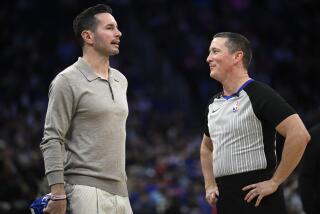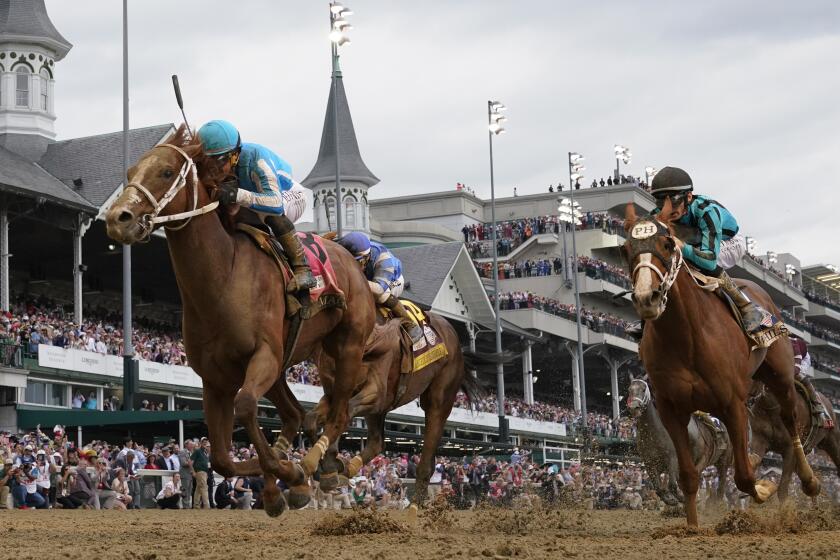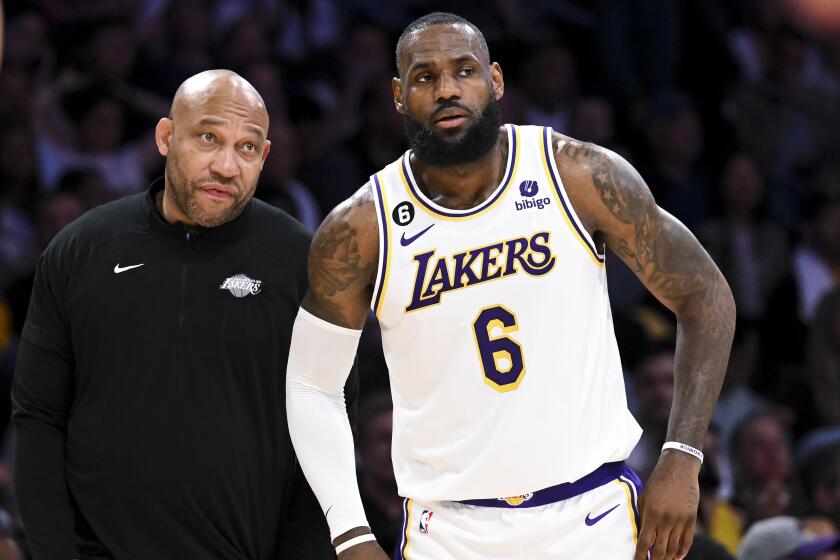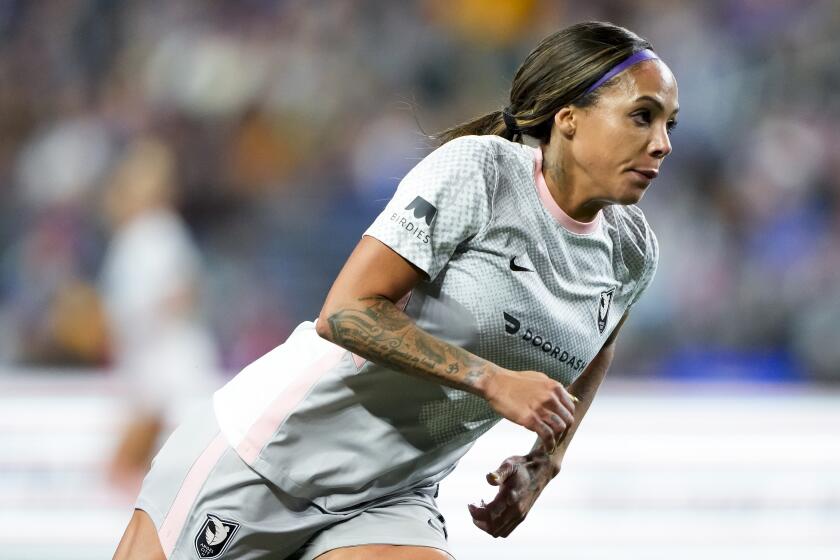AN NFL UMPIRE’S . . .LIFE IN THE WAR ZONE : For His Own Protection, This Official Must Read Defenses <i> and</i> Offenses; Draw Plays Are Murder
Gordon Wells thought it was all over.
“I had that funny, floating feeling as I was going down that, well, it finally happened,” he recalled. “There was no way I could come out of it without being brutally hurt. But as I lay there, I couldn’t feel anything really hurting bad. So I got up. I was shaky for a week.”
Is Wells a sky diver? A matador? A latter day Evel Knievel jumping over the fountains at Caesars Palace?
None of the above. Wells is an umpire in the National Football League, which may be the most dangerous officiating job in sports.
Officials sometimes are called zebras because of the striped shirts they wear. This particular zebra spends his fall Sunday afternoons trying to avoid being Rammed, Browned and Redskinned, or devoured by Lions and Bengals and Bears. Wells was one step away from being steamrolled by William (the Refrigerator) Perry at Chicago Monday night.
The umpire is the only official whose position demands that he be in the middle of the action, lined up behind the defensive line in the area of the linebackers.
“It’s the most specialized spot of all, and a lot of the other officials won’t touch it,” Wells said. “They’re used to being on the outside with a sideline or an end line behind them. We’ve got people all around us.”
Not only that--now they are sometimes threatened from above by a miniature TV camera, called a skycam, which runs along suspended cables.
“That thing will swoop down on you all of a sudden and somebody will yell,” Wells said. “At times it looks like it’s maybe eight feet (up).”
So far, they haven’t come up out of the ground at him.
Wells, who lives in Huntington Beach and is chairman of the health and physical education department at Harbor College in Wilmington, has been an NFL official for 14 years. He worked in the Pacific 10 for five years before that. Two years ago he worked Super Bowl XVIII at Tampa, Fla., as part of what he called an all-star crew selected on graded efficiency during the season.
Wells is easy to spot. He is 6 feet 2 inches and 210 pounds. He is usually the guy picking up his yellow marker after a holding call. His primary duty is to watch the clutching and grabbing in the pit where the linemen play.
“Of all the positions in the NFL, umpire is the hardest one to make the transition from college to pro,” he said. “All of the others are very similar in what they’re calling. But the biggest difference in the college and NFL rule books has to do with holding and that type of thing.
“I get incensed when people talk to me about no harm, no foul. When people watch a game and say, ‘There’s holding on every play,’ yes, if you’re talking about what we learned in high school and college.
“But our rule, boy! If you read the definition of offensive pass blocking and run blocking, it’s different. There’s always (key) words that pop out: (anything) ‘that puts the opponent at a disadvantage or gains an advantage.’ ”
The pay is good, and all officials are paid the same, according to tenure: $450 a game to start, up to $1,200 for a 15-year official, plus $3,000 for a playoff game and $5,000 for a Super Bowl.
But, at least for umpires, the risks are high, too.
“I’ve had two knee surgeries,” Wells said. “Got caught in a pile in a preseason game between the Raiders and Pittsburgh in ’75 at Berkeley. Later I got hit again on the same knee.
“You get bumped and scraped a lot. I’m lucky. I’m at a college where I can go into the weight room and lift three days a week. It keeps you firm and tight.”
Wells, 56, appears trim and fit--and he doesn’t need glasses, except to read. He was head coach at Narbonne High School for six years and defensive coordinator at Harbor for eight, a job that prepared him for his assignment.
“Most people in the league hate being an umpire,” he said. “I’m very comfortable. I stood there as a coach for God knows how many years every afternoon watching the players. You don’t get concerned with all the mirage of hitting. You’re still seeing what’s happening.
“Too often at the high school level there are big, overweight, older guys who, because they don’t have to run much, end up as umpires. But when you get into the college and pro level, that’s the last place you want a guy that can’t react and can’t move. If you can’t move and can’t read the play, you’re in trouble.”
The officials, without pads, aren’t protected at all as the players are. They must survive on their wits and instincts.
Wells said: “You have to have a great deal of trust in the players. We’ve got our backs to all those defensive backs and linebackers most of the time. The worst thing you can do is watch the ball. Anybody could do that. You have to read the keys, just like a middle linebacker.
“The predominant defense has two linebackers fairly close inside. Normally, we’re somewhere between those two. At the start of the play you’re focused in on the center and two guards. The instant you get movement you’ve got to read where that play is directed.
“As we read flow you usually take a jab step back that will give you two feet for the linebacker to get by in front of you, then wheel to the point of attack. A lot of times you don’t see the ball until it arrives at the hole. If you’re looking at the ball and the ball carrier, you’re just gonna get killed, plus you’ll never know where the play is going because they’re doing all that faking.
“Where you get into the trouble is when there’s a tremendous job of faking that will bring people one way, then all of a sudden they wheel and come back and you’re in the way and they hit you from behind. The majority of my bad collisions have been from the back.
“The other one that is really a harrowing experience is the draw play, if they’re clever at disguising it, which they are. These are the best people in the world.
“When we read pass, our job is to come to the line of scrimmage as quickly as we can to clear for the linebackers and the crossing receivers. You don’t want go come up there and suddenly find Walter Payton coming at you in a hole where there’s only room for one of you. Instead of picking an opening, we try to trail a defensive lineman to the line of scrimmage.
“The other thing is, you get an awful lot of balls thrown right at your head, especially me. I’m tall. I’ve been hit in the head a couple of times while I’m watching blockers.”
Umpires always have better war stories than other officials.
“I got hit hard twice last year,” Wells said. “The opening game in Houston with the Raiders and the last game at Cincinnati with Buffalo.
“At Houston it was a misdirection play. I had picked up the blocking and was looking one way. The corner had gone very quickly with a receiver and then suddenly diagnosed it as a run and came back in a hurry.
“He still had his head turned and never saw me and hit me with a full head of steam. It was like being rear-ended. You get a whiplash out of it.
“The worst collision I’ve ever been involved in in all the years that I played or have driven cars was in Cincinnati. It was on a kickoff. I’m on the sideline and come to the center of the field to make sure nobody bothers the defenseless kicker. Then I come upfield between the numbers and the hash mark to look for illegal blocks or holding.
“Again, you’re looking for the point of attack by the blocking. This was one time I miscalculated. I thought it was here and suddenly out of a pile of players came this Cincinnati back (Stanford Jennings, 6-1, 205) and he just appeared out of nowhere.
“All you can do is make a decision real quick: Stand still and hope he’ll cut around you or try to get out of his way. It looked to me like he was gonna go left, so I stepped right. The instant I made my decision he went that way, too.
“He hit me going absolutely full speed. That would have been bad enough, but I know from looking at the films there were four defensive people trying to tackle him. When he hit me he knocked me into one, two, three and four.
“I was completely in the air. It made all of the late Sunday night TV shows and the CBS Morning News the next Friday (as) the hit of the week.”
That’s when Wells had that “funny, floating feeling.” But when he realized he wasn’t hurt, he asked referee Chuck Heberling to take a TV timeout so he could collect himself.
“Then we went on with the game,” Wells said.
More to Read
Get our high school sports newsletter
Prep Rally is devoted to the SoCal high school sports experience, bringing you scores, stories and a behind-the-scenes look at what makes prep sports so popular.
You may occasionally receive promotional content from the Los Angeles Times.






